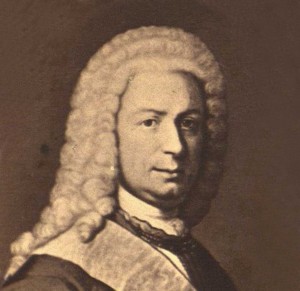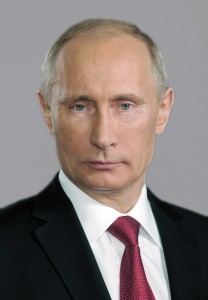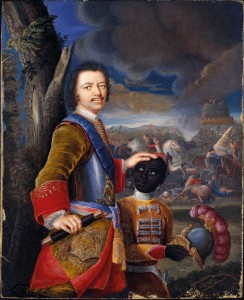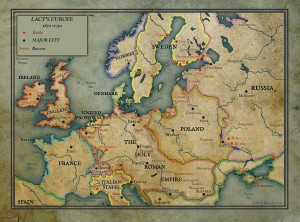Peter Lacy, ‘the Prince Eugene of Muscovy
Published in Early Modern History (1500–1700), Features, Features, Issue 6 (November/December 2014), Volume 22
Peter Lacy—unable to gain employment in the Hungarian service after the disbanding of the Irish Jacobite Army following the Treaty of Ryswick (1697), he entered the Polish service under Charles Eugene, duc de Cröy, who recommended him to Peter the Great
Enters Russian service
In 1723 he took his seat in the College of War, rode behind the imperial carriage at the coronation of the new tsarina, Catherine (the Great), in 1725 and became a knight of the order of Alexander Nevsky and commander-in-chief of St Petersburg, Ingra and Novgorod. In the general staff lists for 1728 his name is ranked third among the six full generals of the Russian army. A further indication of his standing is the fact that his signature always occupied first place on all subsequent College of War reports to the tsarina. In 1726/7 Catherine dispatched Lacy to expel Maurice de Saxe, later marshal of France and victor of the Battle of Fontenoy (1745), from the duchy of Courland. In 1733 he accompanied his confederate, General Burkhard Christoph Munnich, into Warsaw to establish Augustus II ‘the Strong’ of Saxony on the Polish throne in opposition to Stanislas Leszczynski, father-in-law of Louis XV of France and subsequently duke of Lorraine. When Danzig (now Gdansk) fell after 135 days, Augustus rewarded him with the order of the White Eagle. In 1733 he drove Stanislas from Thorn. Later at Busawitza, at the head of less than 2,000 men, he routed an army of 20,000, an action that finally decided the war of the Polish succession. He later joined an imperial army under Prince Eugene of Savoy to campaign against Stanislas’s French allies. Lacy occupied Heidelberg during the course of this campaign; the spectre of 10,000 Russian soldiers on the Rhine haunted Cardinal André-Hercule de Fleury, chief minister of France, who feared that Vienna would inundate Germany with ‘barbarian’ troops. However, the carriage and conduct of Lacy’s troops greatly impressed Prince Eugene of Savoy, ‘the Atlas of the Holy Roman Empire’, to whom Lacy would later be so favourably compared by Frederick the Great of Prussia. Lacy received the patent of field marshal on his way back from a visit to the imperial court in Vienna.

Vladimir Putin—the latest Russian leader to intervene in the Crimea. Its original conquest by Russia was spearheaded by Irishman Peter Lacy.
On the outbreak of war with Turkey the following year Lacy moved to reduce Azov, a key strategic citadel which would become a lasting monument to Russia’s ambitions in the south. The Turkish bashaw capitulated after three months, leaving behind 300 pieces of ordnance and nearly 300 Christian captives. In the following year Lacy took command of all Russian forces in the Crimea. He stormed the previously impregnable fortress at Perekop, which dominated the isthmus of the same name that connects Crimea to the mainland, surrounded the castle of the Aga of the Guards on the Don and the Dneiper, captured the stronghold of Kaffa at the head of a force of 30,000 Cossacks, overran the Crimea as far as the Tauric Mountains and ravaged the countryside with fire and sword. In 1739–41 his forces returned to the Ukraine as a consequence of renewed hostilities with Sweden, and he later commanded against them in Finland.
The wily field marshal took no part in the coup that brought Tsar Peter’s niece, Elizabeth, to the throne in 1741, but his intervention in a mutiny among the Russian Guards purportedly saved St Petersburg and perhaps the whole empire. Dispatched as commander-in-chief of the Russian army to the Finnish theatre, he captured the fortified town of Frederickshamn without the loss of a single man. Ignoring orders to conclude the campaign, he engaged a force of 17,000 Swedes at Helsingfors (Helsinki) and forced them to capitulate. The new tsarina joined him on his ship for the celebrations and presented him with a ring of great value and a golden cross. Lacy pressed on with a vigorous assault on Hongo and his final push against Stockholm was frustrated only by the conclusion of the war. He subsequently served as governor of Riga and Livonia (northern Latvia, southern Estonia) before retiring to his estates at Livonia, where he died on 11 May 1751 aged 72.
Éamonn Ó Ciardha is a Senior Lecturer in History at the University of Ulster.
Read More: History and historiography
Further reading
S. Dixon, The modernisation of Russia, 1676–1825 (Cambridge, 1999).
J.C. O’Callaghan, Irish brigades in the service of France (repr., Shannon, 1971).
P.J. O’Meara, ‘Field Marshal Peter Lacy, an Irishman in eighteenth-century Russia’, in T. Artemieva, P. Jones & M. Mikeshin (eds), The Philosophical Age Almanac 15—Scotland and Russia in the Enlightenment (St Petersburg, 2001), 82–90.
R. Wills, The Jacobites and Russia, 1715–50 (Haddington, 2002).


















